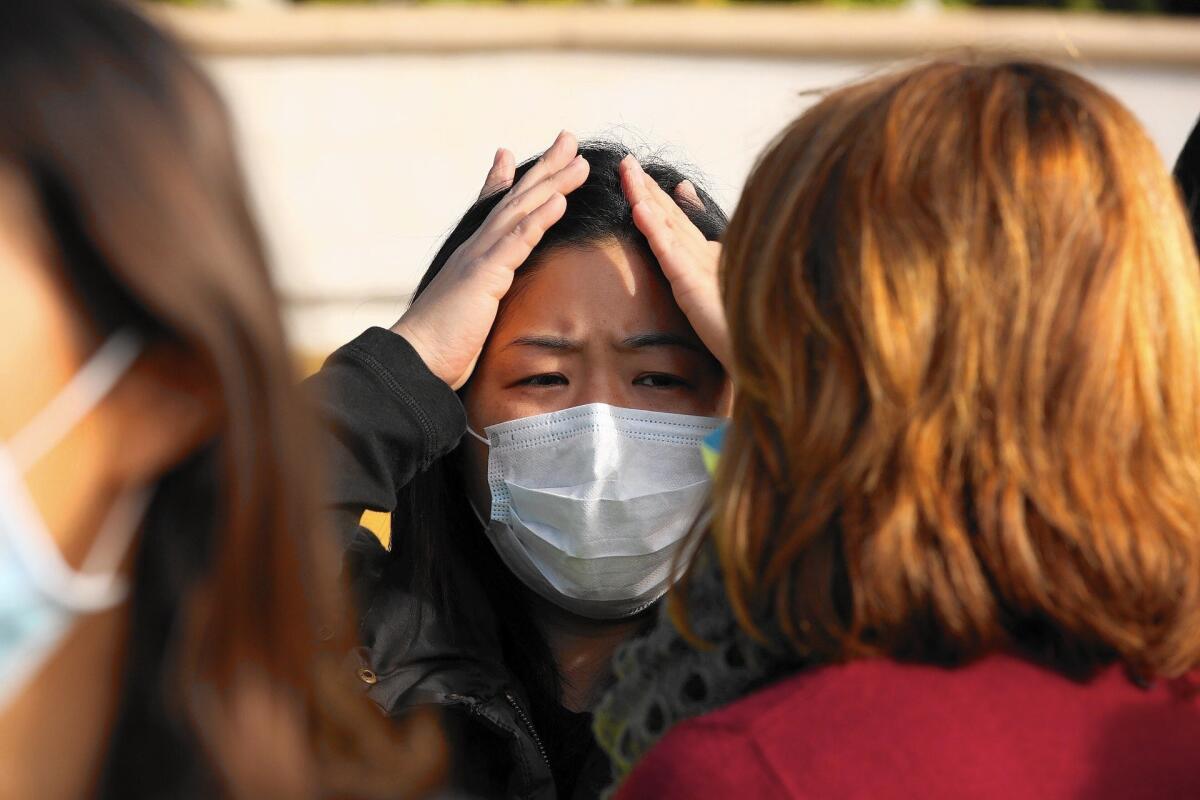Odors from Porter Ranch gas leak are just doing their jobs — too well

Porter Ranch residents suffering from headaches, nausea and other symptoms from a natural gas leak that has displaced thousands are assigning blame to a damaged well in the Santa Susana Mountains north of Los Angeles.
But the real culprit is a safety feature in a transmission system that carries gas from hundreds of miles away.
Producers in Texas, the Midwest and Rocky Mountain states inject trace amounts of two foul-smelling chemicals into the gas for a reason that now seems a rich paradox: to let noses sniff out the presence of the otherwise odorless methane.
Join the conversation on Facebook >>
The gas is then pumped by pipeline to Southern California Gas Co.’s Aliso Canyon facility for storage.
As the leak stretches into its third month, health officials and environmental regulators say that the leaking gas dissipates considerably before reaching residential areas. By the time it reaches the nearest homes, more than a mile away from the stricken well, concentrations are below the detection limits of air quality monitoring equipment and would be harmless to residents — if it weren’t for that putrid additive.
The sulfur-like compounds it contains, called mercaptans, are not toxic or damaging to the body and do not post long-term risks, public health officials and environmental experts say. It’s the odor itself that is causing health problems in the San Fernando Valley community.
“It’s so noxious people have a physiologic response,” said Dr. Cyrus Rangan, director of the Los Angeles County health department’s Bureau of Toxicology and Environmental Assessment.
The additive is a mix of two chemicals, tertiary butyl mercaptan and tetrahydrothiophene, said Glenn La Fevers, storage operations manager for Southern California Gas. Odorants, as they are called, have been used in gas for so long that people are conditioned to associate their skunk-like smell — which draw comparisons to rotting cabbage, smelly gym socks or rotten eggs — with danger and unease, even at levels close to zero.
The nose’s threshold for detecting those chemicals is so low “you can smell them even at low concentrations, which is why they make good warning compounds,” said Michael Kleinman, a professor of toxicology at UC Irvine
Sense of smell varies widely among the population, with women and children typically having higher sensitivity than men and older people. That’s why some people might be overwhelmed by the odors and react severely while others may not so much as catch a whiff.
Natural gas is mostly methane, a potent but nontoxic greenhouse gas. But it also contains small amounts of benzene, toluene and other carcinogens that authorities are testing for in the community. So far, monitors have not found those chemicals at levels any higher than amounts typical in Los Angeles air.
The South Coast Air Quality Management District has received more than 1,500 odor complaints since the leak began Oct. 23. On Thursday, the agency sent a trailer to Porter Ranch to continuously monitor levels of methane and other gases as well as mercaptans and other sulfur compounds.
The gas company and the school district are also monitoring air quality.
The leak has drawn heavy scrutiny from environmental regulators and local officials, including Los Angeles City Council members and county supervisors who have sharply criticized Southern California Gas and demanded investigations and health studies. Residents and the Los Angeles city attorney have sued the company over the leak and air quality officials have cited it for public nuisance violations.
On Thursday, Los Angeles school district officials backed a plan to relocate students and staff members at two Porter Ranch schools and sue the gas company if necessary to recoup the costs.
Under orders from the health department, nearly 2,000 households affected by odors from the leak have been relocated, moving into hotels, rental homes, apartments or other temporary accommodations, at the gas company’s expense.
As worries have mounted among residents, county health officials have emphasized that there is no evidence the mercaptans pose long-term health risks, even in workplace and industrial settings, where people are chronically exposed to elevated levels of the odor-causing chemicals.
A 2012 study by the U.S. Centers for Disease Control and Prevention found that residents within a 2-mile radius of a six-month leak of such chemicals from a natural gas facility in Prichard, Ala., experienced short-term symptoms, similar to those reported in Porter Ranch, but no lasting health consequences.
Such assurances have done little to calm residents whose lives have been disrupted.
Lifelong Porter Ranch resident Dee Ann Abernathy, whose family of six has relocated, said her 6-year-old daughter has experienced several episodes of severe vomiting and has broken out in hives since Nov. 14. Abernathy, 39, bristles at suggestions that fumes emitted by the failed well may not have long-term harmful effects.
“My child is not a guinea pig and no one can guarantee that this is not harming her health,” Abernathy said. “I have to wonder whether people who insist there are no long-term effects from this leaking well would continue to do so if it was their daughter vomiting day and night.”
Communities throughout the region have complained of noxious odors emanating from urban oil fields, landfills, rendering plants and other industrial sites, sometimes waiting for years for action by government authorities.
Rangan, who has worked for the health department since 2003, called the number of people leaving their homes over the odors in Porter Ranch “staggering.” He said he is aware of no prior incidents in which the county has ordered the relocation of residents in response to an environmental release, even in cases in which facilities have released dangerous pollutants with long-term health risks.
“This is a new situation for a lot of people, so we don’t have a lot to go on,” Rangan said. “This is a very enormous and complex problem.”
The health department is not keeping numbers on how many people have sought medical care because of the gas leak, but has received nearly 300 inquiries from people who have wanted to discuss their health symptoms with county authorities, “orders of magnitude higher than anything we’ve seen,” according to Rangan.
Rangan said he has spoken with healthcare providers in the area describing a wide range of ailments, including headaches, nausea, stomach discomfort, dizziness and respiratory irritation. As the leak drags on, he added, “the frequency and the severity of those symptoms seems to be, if anything, increasing.”
NEWSLETTER: Get the day’s top headlines from Times Editor Davan Maharaj >>
Health officials are also concerned that the company’s attempt to fix the leak by drilling into the ground to construct a relief well could release radon, a radioactive, naturally occurring and odorless gas that is found in geologic formations and causes lung cancer. But Rangan says such a release “is a pretty remote possibility” that would pose a greater risk to workers at the site than Porter Ranch residents.
The gas company has told state regulators that it will complete drilling a relief well by Feb. 24, but company officials said in an interview Thursday that repairing the leak could take until the end of March.
The gas company said it has pursued several other options to reduce emissions from the leak. To relieve pressure, the company has withdrawn gas from the natural sandstone formation that serves as a storage reservoir. The gas company also has hired engineers to study capturing gas at the surface to redirect it or filter out the offensive compounds.
“We’re working very hard to reduce the amount of odors in the community,” said Gillian Wright, vice president of customer services for the gas company.
The company has also proposed spraying a chemical into the air at the storage facility to neutralize the odors, an idea met with skepticism by residents and local authorities.
About 1,000 people have requested home installation of activated carbon air filtration systems, devices that the gas company has offered to residents. Nearly 100 have been installed so far, the company said.
Rangan called the use of filtration systems a stopgap measure and said the health department does not endorse them as a remedy.
“There’s really only two ways to solve a problem like this: Either get rid of the odor or get yourself away from the odor,” Rangan said. “There’s no middle ground that is necessarily an effective solution.”
Times staff writer Louis Sahagun contributed to this report.
ALSO
Some lenders are judging you on much more than finances
Earthquake: 3.1 quake strikes near San Ramon, Calif.
Limited by U.S. banking rules, pot businesses rely on bags of cash and armed guards
More to Read
Sign up for Essential California
The most important California stories and recommendations in your inbox every morning.
You may occasionally receive promotional content from the Los Angeles Times.











